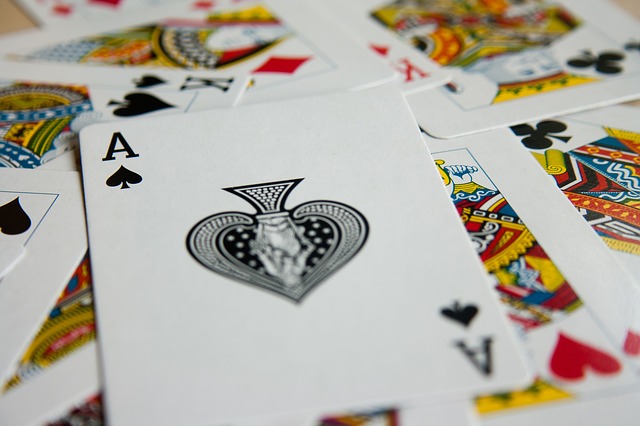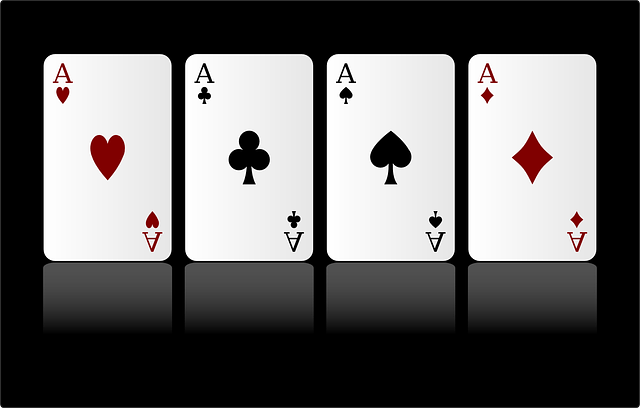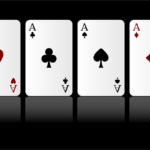
The Ace card, also known as the “one” card, is a powerful and versatile card in many card games, including poker, blackjack, and many others. In some games, the Ace is the highest card, while in others it is the lowest.
Regardless of its rank, the Ace card has come to symbolize many different things beyond just its role in games of chance. (See also Is an Ace a Face Card or Number Card?)
The Ace Card in a Deck
The Ace card is one of the most important cards in a deck of playing cards, regardless of the specific game being played. It is typically the highest-ranking card in the deck, and is often associated with power, strength, and opportunity.
In a standard deck of playing cards, which typically contains 52 cards, there are four Ace cards, each of which is associated with a different suit. The four suits are typically depicted as hearts, diamonds, clubs, and spades, with each suit featuring a unique design and color scheme. (See How Many Aces are in a Deck of 52 Cards?)

The Ace card is typically depicted as a single symbol or design, often featuring the suit symbol at the center of the card. In some decks, the Ace card may feature additional decorations or imagery, such as ornate borders, intricate patterns, or other decorative elements.
In many games, the Ace card serves as a wildcard or a “trump” card, meaning that it can be used to represent any other card in the deck. This makes the Ace a highly versatile and powerful card, capable of turning the tide of a game in an instant.
In other games, the Ace card may have specific values or functions depending on the rules of the game. For example, in the game of blackjack, the Ace card can be worth either one point or 11 points, depending on the player’s strategy and the other cards in their hand. In the game of poker, the Ace card is typically the highest-ranking card, and can be used to form a royal flush, the highest-ranking hand in the game.
History of the Ace Card
The Ace card has a rich and fascinating history that spans several centuries and multiple cultures. While the origins of the Ace card are somewhat obscure, it is generally believed to have originated in Europe during the Middle Ages, when playing cards first became popular among the nobility and wealthy merchants.
The earliest versions of the Ace card were simple and straightforward, with a single symbol or design indicating its value. Over time, however, the Ace card began to take on more complex and symbolic meanings, reflecting the changing cultural and social contexts in which it was used.
In many European countries, for example, the Ace card came to be associated with royalty and nobility, reflecting the fact that it was often the highest-ranking card in the deck. In France, the Ace card was sometimes referred to as “L’As,” or “The Ace,” a term that is still in use today.
In other parts of the world, the Ace card took on different symbolic meanings. In China and other parts of East Asia, for example, the Ace card was often associated with the number one, reflecting its status as the first card in the deck. In Japan, the Ace card was sometimes depicted as a dragon or other powerful creature, reflecting its importance in games of strategy and skill.
As playing cards spread throughout Europe and eventually around the world, the Ace card became a symbol of many different things, from power and strength to opportunity and potential. It was used in a wide range of games and activities, from simple gambling games to complex strategy games, and its versatility and flexibility made it a popular choice among players of all levels of experience.
Today, the Ace card remains an important part of the cultural and social landscape, both in the world of card games and beyond. It is still used in a wide range of games and activities, from classic games like poker and blackjack to modern games like Magic: The Gathering and Hearthstone. And its symbolic meanings and associations continue to evolve and adapt to the changing times, reflecting the enduring appeal and significance of this powerful and versatile card.
Ace Card Meanings and Symbolisms
One of the most common meanings associated with the Ace card is that of strength or power. In many games, the Ace is the most valuable card, often worth more points or able to beat out all other cards. This has led to the Ace becoming a symbol of strength and success in many contexts outside of card games. For example, someone who is described as having an “ace up their sleeve” is seen as having a secret weapon or advantage that gives them a significant edge over their competition. Similarly, someone who is said to have “aced” a test or task is seen as having performed exceptionally well, showing both skill and knowledge.
Beyond strength and power, the Ace card can also represent leadership and control. In some games, the Ace is the card that is used to lead off a round, setting the tone and establishing the rules for the game to follow. This has led to the Ace being associated with leadership and control in other contexts as well. For example, someone who is described as the “ace” of a particular field or industry is seen as the person who is in charge or who sets the standard for others to follow. Similarly, someone who is described as an “ace pilot” or an “ace driver” is seen as someone who is in control and able to navigate challenging situations with ease.
Another meaning associated with the Ace card is that of opportunity or potential. In many card games, the Ace can be used to complete a winning hand or to turn a losing hand into a winning one. This has led to the Ace being seen as a symbol of opportunity or potential in many other contexts as well. For example, someone who is described as having an “ace in the hole” is seen as having a hidden advantage or opportunity that they can use to their advantage. Similarly, someone who is described as having “aced” an interview or presentation is seen as having demonstrated their potential and ability to succeed in their chosen field.
Role of the Ace in Card Games
In addition to its symbolic meanings, the Ace card has also played an important role in the development of many different card games. In games like poker and blackjack, the Ace is often used as a wildcard, able to represent any other card in the deck. This has made the Ace a crucial part of many different strategies and tactics used by players, leading to countless hours of study and analysis in order to better understand the potential of this powerful card.
In some games, the Ace card is also used to trigger certain special effects or bonuses. For example, in the game of Hearts, the player who wins the Ace of Hearts receives bonus points, while in the game of Spades, the player who wins the Ace of Spades has the power to trump any other card. These special effects have made the Ace a highly sought-after card in many different games, and have led to the development of countless different strategies and tactics designed to help players get the most out of this powerful card.
Despite its many meanings and uses, the Ace card remains one of the most enigmatic and mysterious symbols in the world of card games. Whether seen as a symbol of strength, leadership, opportunity, or something else entirely, the Ace has played an important role in the development of countless different games, and has captured the imaginations of players and enthusiasts around the world for generations.
One of the reasons why the Ace card has become such an enduring symbol in the world of card games is its versatility. Unlike many other cards, which have a fixed value or function, the Ace can be used in many different ways depending on the game being played and the strategies being employed by the players. This versatility has made the Ace a crucial part of many different games, and has allowed players to develop a wide range of different tactics and approaches when using this powerful card.
At the same time, the Ace card has also become a symbol of the unpredictability and chance that are inherent in many card games. Because the Ace can be used in so many different ways, it can sometimes be difficult to predict how it will be used by other players or how it will impact the outcome of a game. This has led to many different strategies and approaches being developed by players in order to take advantage of the potential of the Ace while minimizing its risks and drawbacks.
Final Thoughts
Ultimately, the Ace card is a symbol of both power and uncertainty, of strength and unpredictability. Whether seen as a symbol of leadership, opportunity, or potential, or simply as a powerful card in a game of chance, the Ace has captured the imagination of players and enthusiasts around the world for generations.
Whether you are a seasoned card player or a newcomer to the world of card games, the Ace card is sure to remain a powerful and enduring symbol of the many different meanings and uses of this fascinating and endlessly intriguing pastime.
The magician started magic as a kid and has learned from some of the greats. He loves to share his knowledge with others and help out with the subtleties he’s learned along the way.
Follow on YouTube at the link below to get free tricks and advice!


